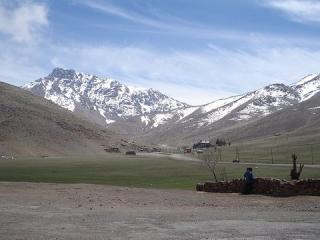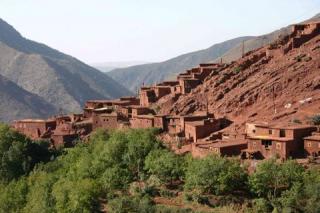Walking Treks
We offer treks in a number of regions of the Atlas Mountains. All our treks can be adapted to suit your circumstances – time available, level of fitness, group size – and include the most popular areas with trekkers : The Toubkal region, M’Goun Massif, Jebel Sahro, Jebel Sirwa and the Amezmiz Plains.
To help you to find the best trek for you, we recommend you read the summary descriptions for each area which are designed to give you an idea of what to expect. The detailed descriptions of the treks provide information about the route, accommodation and degree of difficulty. These itineraries are not fixed and may be changed usually in the interests of safety because of bad weather.
Most of our treks are possible in the winter, though we do not trek in the M’Goun area in the winter because of snow and the frequent high winds. The Toubkal area is recommended if you have limited time but want to experience the Atlas Mountains in winter. Most of our treks , excluding Toubkal summit, are possible in winter without crampons or special equipment. The best areas for longer winter trekking are the Jebel Sahro and Jebel Sirwa areas which are further south towards the Sahara.
We also recommend that you read our Frequently Asked Questions section which gives advice and information which we hope will help you choose the best trek for you.
Please browse the regions below and click on the title to view the treks within that region OR you can view our list of treks by clicking here.
Trek Regions
Less than an hour from Marrakech, Amezmiz village and plain offers varied and relatively low level walking. It is an ideal introduction to the Atlas mountains and the Berber culture and way of life.
The highest point of the trek is 2200m and there are stunning views throughout the trek as we follow the Amezmiz valley and climb up through typical Berber villages with terraced fields of cereals, potatoes and orchards of olives, cherries and walnuts.
This trek is highly recommended for those who want to experience the beauty of the Atlas, Berber villages and people, without the demanding walking of most of our treks.
A typical day involves about 5 hours walking, with time for a leisurely picnic lunch, before arriving at our overnight stop with time to explore and relax.
The Jebel Sahro is a mountain range between the High Atlas and the Sahara and is separated from the High Atlas by the valleys of the Dades and the Draa. Scenically it is an area of dramatic contrasts : palm trees, rose hedges, oases and stark, barren volcanic mountains and mud brick villages. Highlights include a glimpse of the Tadaout n'Tablah mountains and an amazing upright rock pinnacle named 'Bab n'Ali' - translated as the 'Gates of Ali'
It is very hot in the summer and can be bitterly cold in winter. For this reason a good time to visit is from October to March when temperatures during the day are around 20 degrees Centrigrade, though the nights are well below freezing.
For trekkers who want to get off the beaten track Jebel Sahro is ideal. The highest point of the Sahro is 2712m with most passes between 1500m and 2500m. Most of the walking is easy with about 6 hours walking each day – leaving plenty of time for enjoying the scenery and relaxing at the end of the day.
The Sirwa Massif lies to the south of the Toubkal area on the boundary between the High Atlas and the Anti-Atlas.
It is an area of beautiful valleys and mountain peaks, with typical Berber villages surrounded by almond trees and fields of saffron – the only area in Morocco where saffron is harvested. Sirwa itself is an extinct volcano (3305m) surrounded by a number of other peaks around 3000m. It is snow-capped most of the year. The area is less popular than Toubkal and harder to reach but offers varied and challenging trekking and the opportunity to get off the beaten track.
Although the M’Goun region, to the east of Toubkal, is accessible from Marrakech, it is less frequented by trekkers which may be an attraction for those who wish to get at least a little off the beaten track.
The walking is superb and as challenging and strenuous as anywhere in the Toubkal area. The scenery is different with long ridges and spectacular deep gorges. The summit of M’Goun (4068m) is only just below that of Toubkal (4167m) and well worth the climb. Throughout the area are typical Berber villages with terraced fields and orchards.
This is the most popular area with trekkers : easily accessible from Marrakech, it is an area of stunning scenery, high mountains (including Toubkal, the highest mountain in north Africa at 4167m) and typical Berber villages.
The area is criss-crossed by mule tracks that cross high passes and descend into deep valleys, passing summer pastures and terraces of maize, potatoes and other crops and orchards of walnut, apple and cherry. Imlil is the main trailhead for the area.


